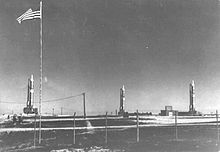848th Strategic Missile Squadron
Appearance
| 848th Strategic Missile Squadron | |
|---|---|
B-17G Flying Fortresses in formation during a mission | |
| Active | 1943–1945; 1960–1961 |
| Country | |
| Branch | |
| Role | intercontinental ballistic missile |
| Insignia | |
| World War II fuselage code[1][a] | 7W |
The 848th Strategic Missile Squadron is an inactive
V-E Day, the squadron returned to the United States, where it was inactivated in November 1945. It was activated as an intercontinental ballistic missile
squadron in 1960.
History
World War II

The
SS Nieuw Amsterdam on 11 April and arriving in the United Kingdom on 25 April. The air echelon flew its planes along the southern ferry route beginning on 12 April.[4]
The squadron arrived at
Once transition to the B-17 was completed on 24 August, the squadron concentrated on
lines of communication during the Battle of the Bulge from December 1944 through January 1945. In the last month of the war in Europe, it carried out interdiction missions to support advancing ground forces.[3] The squadron's last combat mission was flown on 20 April 1945.[4]
Following
Drew Field, Florida in September. It was inactivated there on 7 November 1945.[2]
Strategic missile operations

The squadron was redesignated the 848th Strategic Missile Squadron and organized at
SM-68 Titan I intercontinental ballistic missile, but was only partly operational through March, when it became nonoperational. On 1 July 1961, the squadron was inactivated and its assets transferred to the 724th Strategic Missile Squadron, which was simultaneously activated at Lowry.[2][6][7]
Lineage
- Constituted as the 848th Bombardment Squadron (Heavy) on 14 September 1943
- Activated on 1 October 1943
- Redesignated 848th Bombardment Squadron, Heavy c. 1944
- Inactivated on 7 November 1945
- Redesignated 848th Strategic Missile Squadron (ICBM-Titan) and activated on 13 November 1959 (not organized)
- Organized on 1 February 1960
- Discontinued and inactivated on 1 July 1961[2]
Assignments
- 490th Bombardment Group, 1 October 1943 – 7 November 1945
- Strategic Air Command, 29 February 1960 (not organized)
- 703d Strategic Missile Wing, 1 February 1960 – 1 July 1961[2]
Stations
- Salt Lake City Army Air Base, Utah, 1 October 1943
- Mountain Home Army Air Field, Idaho, 4 December 1943 – 9 April 1944
- RAF Eye (AAF-138),[8] England, 28 April 1944 – c. 26 August 1945
- Drew Field, Florida 3 September – 7 November 1945
- Lowry Air Force Base, Colorado, 1 February 1960 – 1 July 1961[9]
Aircraft and missiles
- Consolidated B-24 Liberator, 1944[2]
- Boeing B-17 Flying Fortress, 1944–1945[2]
- SM-68 Titan I, 1960–1961[6]
Campaigns
| Campaign Streamer | Campaign | Dates | Notes |
|---|---|---|---|
| Air Offensive, Europe | 28 April 1944 – 5 June 1944 | 848th Bombardment Squadron[2] | |
| Air Combat, EAME Theater | 28 April 1944 – 11 May 1945 | 848th Bombardment Squadron[2] | |
| Normandy | 6 June 1944 – 24 July 1944 | 848th Bombardment Squadron[2] | |
| Northern France | 25 July 1944 – 14 September 1944 | 848th Bombardment Squadron[2] | |
| Rhineland | 15 September 1944 –21 March 1945 | 848th Bombardment Squadron[2] | |
| Ardennes-Alsace | 16 December 1944 – 25 January 1945 | 848th Bombardment Squadron[2] | |
| Central Europe | 22 March 1944 – 21 May 1945 | 848th Bombardment Squadron[2] |
See also
- List of United States Air Force missile squadrons
- B-17 Flying Fortress units of the United States Army Air Forces
- B-24 Liberator units of the United States Army Air Forces
References
Notes
- Explanatory notes
- ^ Although assigned the fuselage code, the squadron did not display the code until after the war ended. Watkins, pp. 116–117.
- Ford Motors built Consolidated B-24H-20-FO Liberator, serial 42-94837, The Jinx. This plane was broken up in the United Kingdom in May 1945. Baugher, Joe (26 July 2023). "1942 USAF Serial Numbers". Joe Baugher. Retrieved 29 July 2023.
- ^ Eye had been built by US Army aviation engineers as a heavy bomber base. Anderson, p. 6.
- Citations
- ^ Watkins, pp.116–117
- ^ a b c d e f g h i j k l m n o p Maurer, Combat Squadrons, p. 780
- ^ a b c d e Maurer, Combat Units, pp. 359–360
- ^ a b c d Freeman, p. 261
- ^ SAC Missile Chronology, p. 25
- ^ a b Ravenstein, pp. 292–293
- ^ Maurer, Combat Squadrons, p. 721
- ^ Station number in Anderson, p. 21.
- ^ Station information in Maurer, Combat Squadrons, p. 780, except as noted.
Bibliography
![]() This article incorporates public domain material from the Air Force Historical Research Agency
This article incorporates public domain material from the Air Force Historical Research Agency
- Anderson, Capt. Barry (1985). Army Air Forces Stations: A Guide to the Stations Where U.S. Army Air Forces Personnel Served in the United Kingdom During World War II (PDF). Maxwell AFB, AL: Research Division, USAF Historical Research Center. Archived from the original (PDF) on 23 January 2016. Retrieved 28 June 2017.
- ISBN 978-0-87938-638-2.
- Maurer, Maurer, ed. (1983) [1961]. Air Force Combat Units of World War II (PDF) (reprint ed.). Washington, DC: Office of Air Force History. LCCN 61060979. Retrieved 17 December 2016.
- Maurer, Maurer, ed. (1982) [1969]. Combat Squadrons of the Air Force, World War II (PDF) (reprint ed.). Washington, DC: Office of Air Force History. OCLC 72556.
- Ravenstein, Charles A. (1984). Air Force Combat Wings, Lineage & Honors Histories 1947-1977. Washington, DC: Office of Air Force History. ISBN 0-912799-12-9. Retrieved 17 December 2016.
- Watkins, Robert (2008). Battle Colors: Insignia and Markings of the Eighth Air Force In World War II. Vol. I (VIII) Bomber Command. Atglen, PA: Shiffer Publishing Ltd. ISBN 978-0-7643-1987-7.
- SAC Missile Chronology 1939-1988 (PDF). Offutt AFB, NE: Office of the Historian, Strategic Air Command. 1990. ISBN 978-1521159439. Retrieved 29 January 2018.


